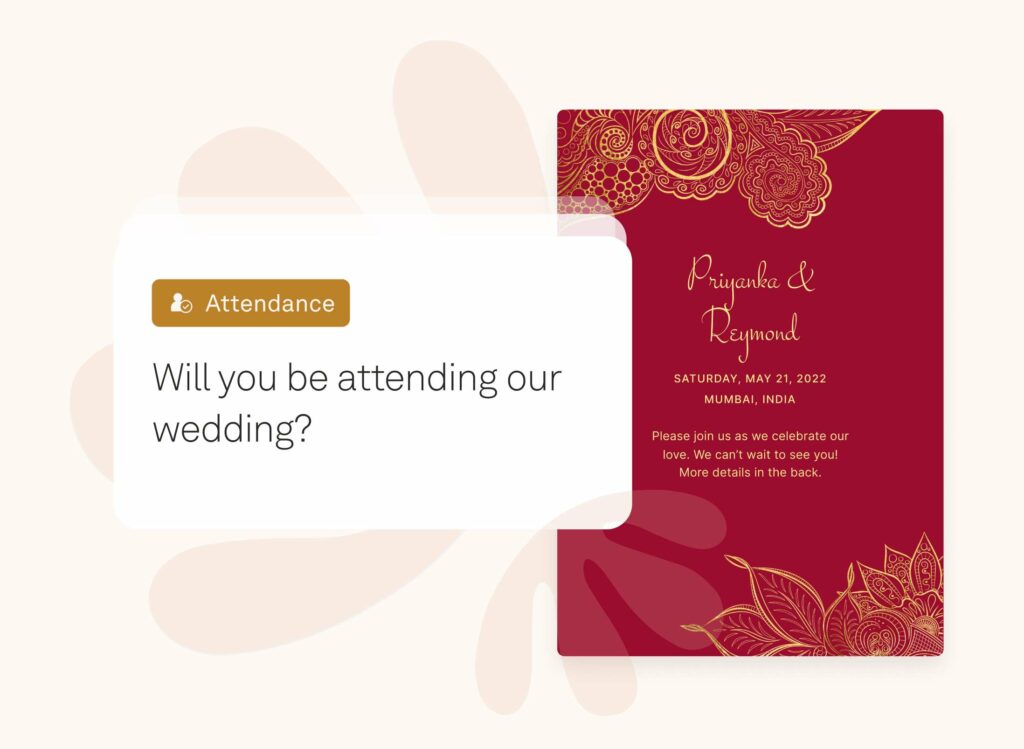Last Updated on March 15, 2021 by Joy Editors
If you’ve chosen a wedding date and venue, shared your save the dates, and settled on the perfect outfits for your big day, you’re probably ready to send your wedding invitations. While it might seem like a simple task at first, many couples feel lost when it comes to preparing and addressing invitations for their various guests. We’ve rounded up the information you need to know to streamline this process, including how to address your wedding invitations in a way that honors common etiquette.
Essential tips
- Use “Mx” for gender-neutral titles.
- The outer envelope lists the guests’ names and mailing addresses.
- The inner envelope lists who in the household is invited to the wedding and whether a single guest is allowed to bring a plus one.
Addressing married couples
When addressing a wedding invitation to a married couple, put both of their names on the same line. It’s customary to list the name of the person you know best first. If you’re close with both people, list their names in alphabetical order. Be sure to look into whether either guest still uses their maiden name.
On the outer envelope, include the couple’s first and last names. You’ll do this the same way for same-sex couples and heterosexual couples. For example:
John Williams and Davis Miller
Or
Mr. John Williams and Mr. Davis Miller
If the couple has the same last name…
John and Davis Williams
Or
Mr. and Mr. John Williams
On the inner envelope, include the first names or only the titles and surnames. For example:
John and Davis
Or
Mr. Williams and Mr. Miller
If the couple has the same last name…
Mr. and Mr. Williams
Addressing unmarried couples
When addressing a wedding invitation to an unmarried couple that lives together, list their names on separate lines on the envelope. The person you know best will go first.
On the outer envelope, include the couple’s first and last names. For example:
Ms. Cecily Garcia
Mr. Noah Smith
Or
Cecily Garcia
Noah Smith
On the inner envelope, include the first names or only the titles and surnames.
Cecily
Noah
Or
Ms. Garcia
Mr. Smith
Addressing plus ones
If you’re allowing guests to bring a plus one, only include the name of the primary guest on the outer envelope. On the inner envelope, include the name of the primary guest and the phrase “and Guest.” For example:
Logan Perez (outer envelope)
And
Logan Perez and Guest (inner envelope)
Addressing children’s names
Traditionally, children’s names are listed only on the inner envelope of their parent’s invitation. The title for a girl is “Miss,” and there is no official title for a boy. If the child is gender-neutral, use “Mx.” If you don’t list the children’s names, the implication is that children are not invited to the wedding.
On the outer envelope, write the family name or only the parents’ names. For example:
The Moores
Or
Mrs. and Mr. Moore
On the inner envelope, write the parents’ names first, followed by their children’s names. All family members go on the same line. For example:
Jennifer, William, Mx. Sam and Miss Bailey
Addressing children 18 and older
Children of guests who are over 18 and don’t live with their parents should receive a separate invitation. You can choose to use titles or leave them out.
On the outer envelope, include their full name. For example:
Mx. Mason Hernandez
Or
Mason Hernandez
On the inner envelope, include their last name and title or only their first name. For example:
Mx. Hernandez
Or
Mason
Addressing professional titles
When addressing a wedding invitation to someone like a doctor, it’s customary to use their professional title. You can use the doctor’s abbreviation or spell out the full title.
On the outer envelope, include the doctor’s name and the name of their spouse, if applicable. For example:
Dr. Laura Reed and Mr. Patrick Thomas
If both guests are doctors, you’d write…
Doctors Laura Reed and Patrick Thomas
On the inner envelope, only use the titles and surnames. For example:
Dr. Reed and Mr. Thomas
When both guests are doctors, the invitation will read…
Doctors Reed and Thomas
Addressing distinguished titles
Military personnel, judges, reverends, and those with other distinguished titles should have their titles mentioned on the wedding invitation. You can spell out the full title, or use an abbreviation like “Lt. Col.”, “Maj.”, or “Capt.” for those in the military, “Hon.” for judges, and “Rev.” for reverends.
On the outer envelope, include the full titles and names. For example:
Honorable Oliver Holmes and General Martin Fisher, US Army
For a reverend, you’d write…
Reverend Sally Lucas and James Lopez
If they’re both Reverends…
Reverends Lucas and Lopez
Addressing RSVP response cards
The last piece of addressing your wedding invitations is adding the return address for the RSVP response card. This card should be addressed to the person who is handling the guest list, which is often who’s hosting the wedding. It’s ideal to have the address printed on the wedding invitation envelope for the response card and include postage.
Addressing invitations for a casual wedding
If you’re having a casual wedding, it’s certainly your choice to skip formalities like titles and surnames. Note that if you have older guests expecting formalities, they may be thrown off by a wedding invitation that only includes their first names. Ultimately, though, remember it’s your wedding, and you get to choose how you address the invitations.
Additional tips
- Before you start addressing your wedding invitations, get organized by going through your guest list and ensuring you have the correct titles and surnames for everyone.
- Avoid using guest nicknames on formal invitations.
- Make your invitations extra special by handwriting them in calligraphy. You can also hire a calligrapher if you don’t trust your handwriting.
- Take your time searching for extra special invitations that exude your style.
Up Next:
Wedding Invitations with Online RSVP
Whether you send traditional paper invitations or go paperless, you can easily collect RSVPs online.


